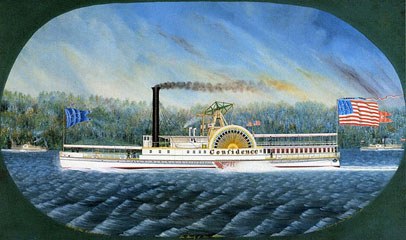The Transportation Revolution
Henry Clay was correct about the necessity of a transportation network for the creation of a national economy. Farmers and manufacturers needed to be able to ship their goods efficiently and cheaply to distant markets. The advances in the decades following the War of 1812 greatly improved their ability to do just that.
In 1825, New York completed the 363-mile Eire Canal linking the Hudson River to the Great Lakes. Though it cost the state $7.5 million, the canal quickly paid for itself.
 |
Learn more about the Erie Canal and its impact. |
Coinciding with the canal boom was the emergence of the steamboat. Robert Fulton, in 1807, demonstrated the commercial potential of a steam-powered vessel. Steamboats reduced both the cost and time required to ship goods by river. The impact was especially dramatic with upstream movement. The steamboat, for example, reduced the trip from New Orleans to Louisville from 90 days to eight days. Between 1820 and 1860, the number of steamboats operating on western rivers increased from 60 to one thousand. States upgraded their ports to address the increased traffic brought by the steamers.

During the 1830s, while steamboats ruled the waterways, railroads were just beginning. By 1840, the nation's rail mileage topped 3,000 miles. Though not cheaper than steamboats for shipping goods, trains could operate year round. And they were faster. Areas with existing infrastructure, like the Northeast, or slow moving rivers, like the South, saw less rail mileage built than farming areas. Railroad construction boomed in the 1850s, partially as a result of the Marshall Courts legal decisions, and the train became the dominant form of transportation in the country.